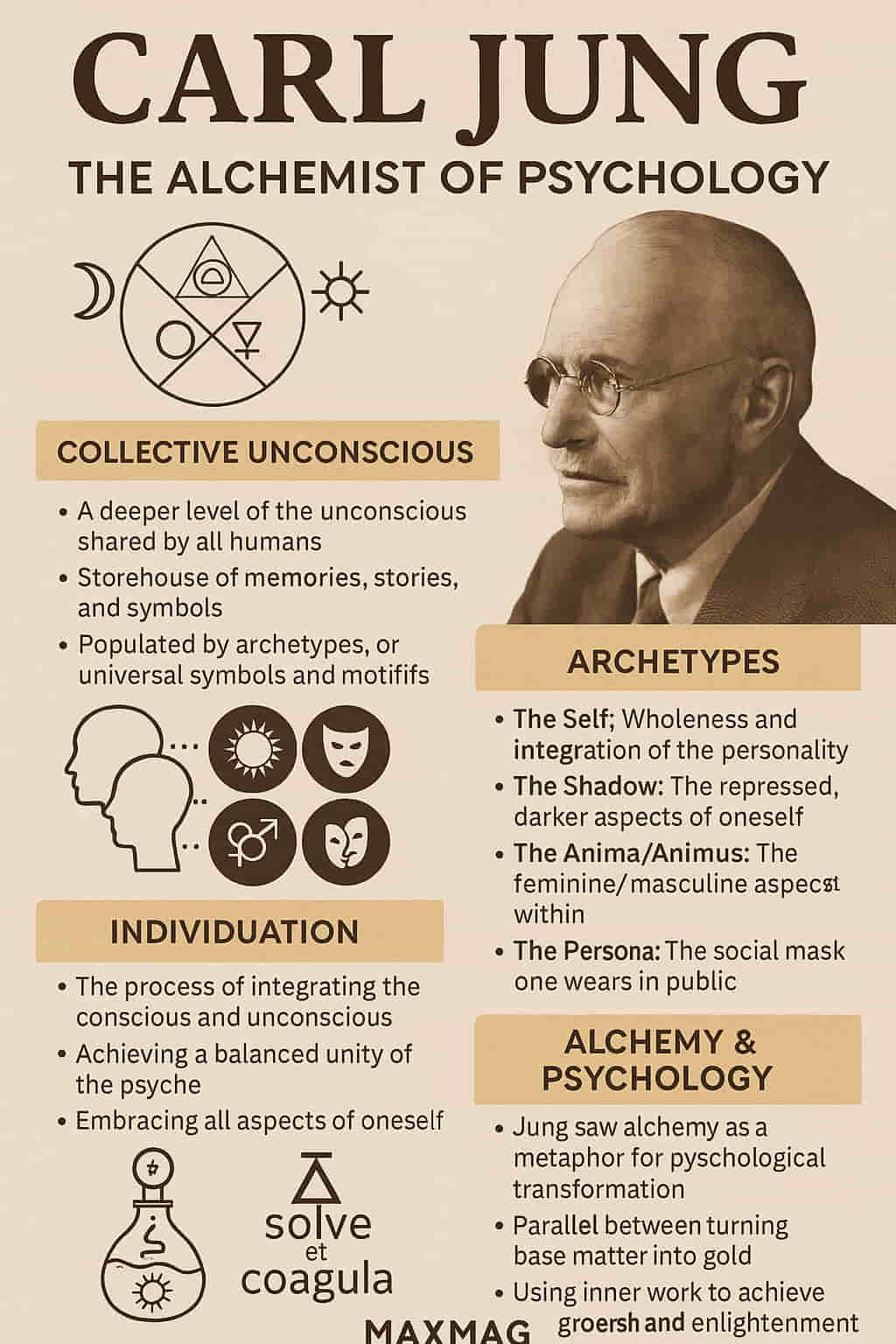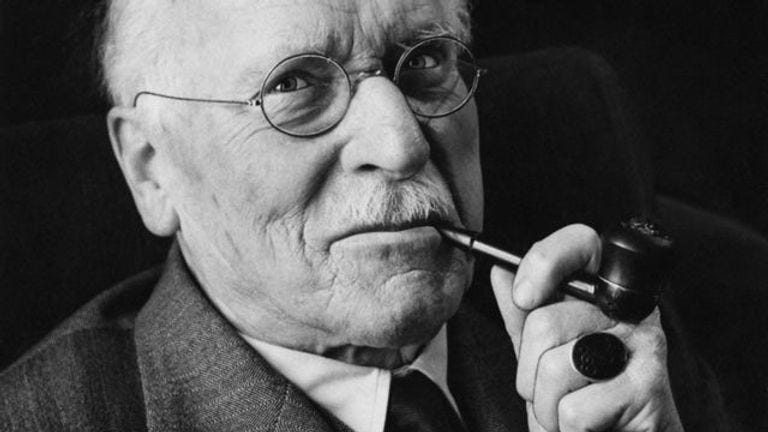
The enduring fascination with Carl Jung’s work can be partly explained by the hunger people feel for deeper meaning in an increasingly materialistic world. For those disillusioned by rigid scientific models or shallow spiritual solutions, Jungian alchemy offers a middle path—a dynamic symbolic process that honors both rational insight and inner wisdom.
In recent decades, Jung’s influence has grown beyond academic psychology and psychoanalysis. He has found a home in integrative medicine, spiritual counseling, and somatic therapy. As people search for authentic methods of self-understanding and healing, the Jungian alchemy meaning becomes increasingly relevant. It offers a structured yet symbolic journey inward, reminding us that psychological suffering is not merely a disorder to be fixed—but a transformation waiting to unfold.
Jung was among the first modern thinkers to affirm the spiritual dimension of psychological pain. He taught that anxiety, depression, and existential dread were not meaningless disorders but symptoms of spiritual starvation. These inner disturbances often signal the need for a deeper shift in how we perceive ourselves and the world.
By aligning his therapeutic model with ancient alchemical principles, Jung emphasized transformation through descent and rebirth. This cyclical process resonates with many today who experience midlife crises, identity collapse, or periods of disorientation. Instead of numbing the pain, Jung’s framework encourages the individual to confront it consciously and extract its symbolic meaning.
Shadow Work and the Role of the Alchemical Nigredo
Perhaps one of the most misunderstood yet critical aspects of Jungian thought is shadow work—the confrontation with the hidden, repressed, or disowned parts of ourselves. This is what Jung referred to as the “shadow,” and in alchemical terms, this confrontation corresponds to the stage of nigredo, or blackening.
The Jungian alchemy meaning here is not simply about acknowledging flaws but embracing the totality of the self. In the nigredo phase, we face emotional darkness—grief, anger, envy, fear—but this stage is essential. Without it, no genuine transformation can begin. Jung believed that many neuroses arose from a refusal to engage with this stage. The patient remained stuck, resisting the very process that could set them free.
In modern therapeutic practice, shadow work might involve exploring difficult memories, examining unconscious biases, or challenging one’s internal narratives. The goal is not to destroy the ego but to strengthen it through honest integration. In alchemy, this process turns black into white—chaos into clarity. And eventually, into red: wholeness.
The Sacred Marriage: Alchemical Symbols and Gender Integration
Another powerful symbol in alchemy that Jung reinterpreted psychologically is the coniunctio, or sacred marriage. This image, often depicted as the union of the sun and moon, male and female, represents the integration of opposites. In Jungian psychology, this refers to the balancing of anima and animus—the feminine and masculine aspects within each individual.
For a man, this may involve developing his emotional sensitivity (anima), while a woman may explore her assertive, analytical qualities (animus). Jung taught that achieving inner harmony required us to transcend gender stereotypes and embrace psychological wholeness. The sacred marriage is not about external relationships—it’s about the union within.
This Jungian alchemy meaning challenges modern binary thinking. In an era where conversations about gender, identity, and integration are vital, Jung’s archetypal model provides a symbolic language to address inner diversity and reconciliation.

Alchemy, Dreams, and the Creative Imagination
For Jung, dreams were not random firings of the brain, but encoded messages from the unconscious. He often described the dreamworld as the psyche’s alchemical laboratory. In dreams, we are presented with images—sometimes terrifying, sometimes enlightening—that guide our development.
A dream of fire, for instance, might signify a symbolic calcination: the burning away of egoic illusions. Water could point to emotional purification. Animals in dreams might represent instincts or guides from the unconscious. Jung insisted that these symbols should not be interpreted rigidly, but individually—each person’s psyche speaks its own symbolic language.
Creative imagination also plays a central role in Jungian therapy. He developed a method called active imagination, which involves consciously dialoguing with dream figures or inner archetypes through writing, drawing, or visualization. This process mirrors the alchemist’s interaction with symbolic material—engaging the soul to produce inner gold.
Science Meets Soul: The Rational Foundations of Jung’s Symbolism
Although Jung is sometimes dismissed as mystical, he took a rigorously empirical approach to the psyche. His theories were based on thousands of clinical observations and decades of study. Jung corresponded with leading scientists, studied Gnostic texts and Eastern philosophy, and documented his findings meticulously.
He believed that myths, symbols, and religious systems were not relics of superstition, but psychic facts—blueprints of the unconscious mind. He often quoted Goethe’s Faust and the Tao Te Ching, noting how similar symbols emerged across cultures and centuries.
This convergence is what gave rise to his idea of the collective unconscious—a shared matrix of imagery and experience. The alchemists, in Jung’s view, were proto-psychologists who symbolically documented the psyche’s inner work. By decoding their symbols, Jung provided modern individuals a way to reclaim their inner life.
Jungian Alchemy Meaning in Contemporary Society
What relevance does Jungian alchemy have in a world dominated by algorithms, screens, and artificial intelligence? In many ways, more than ever. As individuals increasingly suffer from anxiety, disconnection, and loss of meaning, Jung’s model offers depth where surface-level solutions fail.
Burnout, for instance, can be seen as a modern form of nigredo—a breakdown of identity and purpose. Alchemy teaches us that this breakdown can be purposeful. It forces a reevaluation, a clearing of what no longer serves. Through inner work, therapy, or spiritual practice, the burnout sufferer can enter albedo—the reawakening of clarity—and then rubedo, the emergence of a renewed self.
In leadership coaching, alchemical principles are used to guide transformation. In creative industries, archetypes help generate stories that resonate with the collective psyche. In trauma recovery, the symbolic re-integration of shattered parts mirrors alchemical restoration.
The Jungian alchemy meaning endures because it speaks to something timeless: the human desire for wholeness.
Frequently Asked Questions (FAQ)
1. What is Jungian alchemy?
Jungian alchemy refers to Carl Jung’s psychological reinterpretation of alchemical symbols as metaphors for inner transformation. It links the stages of alchemy with personal growth.
2. What is the meaning of nigredo, albedo, and rubedo?
These are symbolic stages in alchemy. Nigredo is the breakdown or darkness phase, albedo the purification, and rubedo the integration and realization of the Self.
3. How does Jungian alchemy apply to modern therapy?
It’s used to interpret dreams, symbols, and inner experiences. Jungian therapists guide patients through symbolic phases of change using alchemical metaphors.
4. Is Jungian alchemy a spiritual or scientific practice?
It’s both. Jung viewed symbolism as psychological data and combined spiritual traditions with clinical insight to create a symbolic method for personal development.
5. Are there modern resources to learn about Jungian alchemy?
Yes. The C.G. Jung Institute, Pacifica Graduate Institute, and the Jung Platform offer courses. Books like Psychology and Alchemy and Man and His Symbols are excellent starters.
6. Can alchemy be practiced today?
Not in the literal medieval sense, but symbolically, yes. It is practiced through dream analysis, shadow work, and active imagination within Jungian psychotherapy and spiritual self-work.




